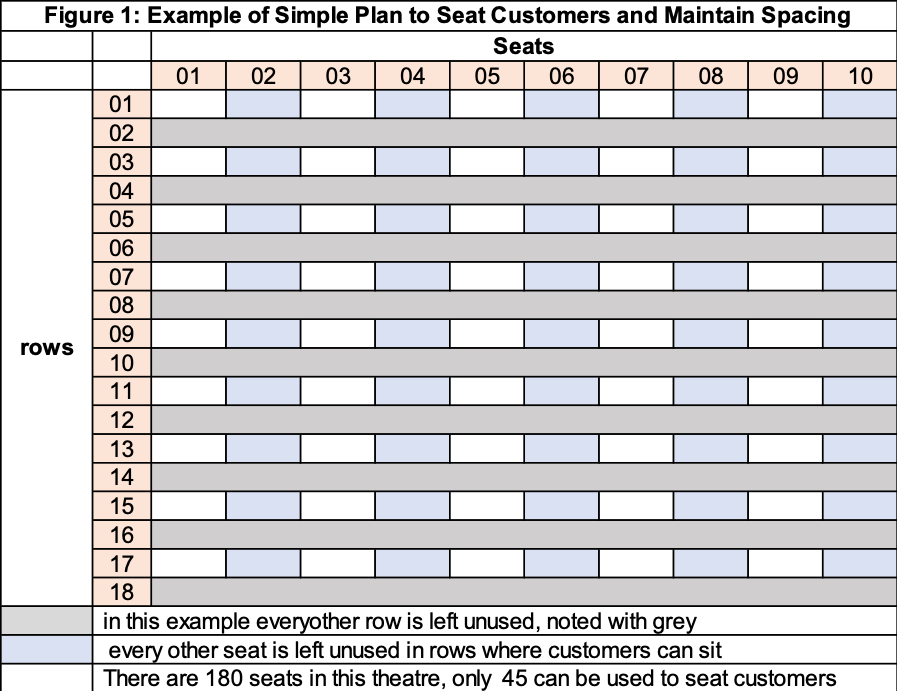Summary:
For most involved in Supply Chain Management, optimization is viewed as one of the three primary methods to create a supply or central plan that matches or balances assets with demand.
Read More: Demand Management’s Partner in Crime
Historically effective use of space involved minimizing unused space or maximizing revenue from a fixed amount of space. COVID-19 has upset the social order. Effective use of space has to account for “social distancing” along with other preferences or requirements. There are simple plans for space such as having customers sit in seats in every other row (Figure 1). These simple plans are clearly inferior in terms of best space use and accounting for preferences such as “most people do not attend an event alone – it would be reasonable to the group of friends who have quarantined together will want to sit next to each other, otherwise, they will not pay to attend.” Optimization methods are well suited for this type of challenge. “Safe Social Distancing at Sports and Entertainment Venues: Here is How to Make It Happen.”
Introduction:
For most involved in Supply Chain Management, optimization is viewed as one of the three primary methods to create a supply or central plan that matches or balances assets with demand (Demand Management’s Partner in Crime and Supply Planning). “Optimization” methods look to find a plan that best meets demand where “best” is some metric (An Example of When Optimization Is Helpful in Central Planning). The traditional areas where optimization is used in SCM include, but not limited to, inventory policy, resource planning, location of resources, and estimating or predicting demand. The methods used for prediction are usually different than those for allocation.
Read More: How To Determine the Best-Fit with Supply Chain Optimization
Historically, effective use of space referred to minimizing the amount of unused space or getting the most revenue for the space available. The Knapsack problem being one of the most famous examples.
COVID-19 upsets the social order
COVID-19 places a premium at maintaining spacing. Every reopening plan requires spacing between individuals or groups of people. (CDC reopening guidelines) The general consensus is the primary mode of quiet (not including coughing or sneezing) COVID-19 spread is exhaling (breathing) and talking where COVID-19 catches a ride to look for new victims to infect. To be infected a person needs to receive a certain dosage or viral load (quantity) which typically only occurs with some sustained exposure. Information about the range of quantities required is currently low.
Learn More: Does a High Viral Load or Infectious Dose Make COVID-19 Worse?
Net is the ability to reopen with limited risk and requires insuring sufficient spacing is maintained. Previously the business or organization goal was to minimize unused space subject to constraints such as maintaining foot traffic pathways, bathroom capacity, etc. Now the goal is to be able to handle the greatest number of customers without violating “distancing requirements” and insuring customers do not feel “crowded”.
Easy Examples
There are a number of spacing examples where people are congregated outside. Golf, tennis, ice cream stands, and outdoor dining. Creating a plan for these situations is pretty easy- maintain 6 to 12 feet of spacing and ensure ventilation.
In Phoenix, Arizona inside restaurants have opened (much to the pleasure of my mom (age 88) and dad (age 91) who enjoy breakfast out). The planning challenge is pretty simple, lay out the tables starting from one corner to maintain spacing. This results in about 50% of the original capacity).
Difficulty ramps up Exponentially
What about seating for sports arenas (indoor and outdoor), music venues, live theatre, and movie theatre? There are certainly simple feasible plans that can be developed manually. For example, people only sit in every other row, and within a row with customers, they sit every other seat (Fig 1). In this example, there are 180 seats in total and only 45 can be used in this plan.

When generating a seating plan for performance venues, a few other items that should be considered are:
- Most people do not attend an event alone. It would be reasonable to assume the group of friends who have quarantined together will want to sit next to each other, otherwise, they will not pay to attend.
- How are the sizes of groups handled? Do you place a maximum size on a group?
- Do you keep aisle seats empty or allow them to be used?
- Depending on the location what is the number of seats that need to be empty between groups?
- How are people with a handicap handled?
- How does the plan account for seating preferences and differences in ticket prices by location?
- What about season ticket holders? Normally the seats owned are the same for all performances – that is fixed. Perhaps their seats need to be dynamic within bounds (if the season ticket holder is in row 3 seat 10, they are guaranteed a seat in rows 1 to 10 in the same section).
I am sure the reader can quickly think of many more “preferences”. Rapidly it becomes clear a manual plan cannot do these considerations justice and there is no “one plan fits all” since performance venues vary considerably between each one and between different entertainment options (hockey and basketball are often in the same venue, but have different seating arrangements). Therefore, venue management needs a dynamic tool to support what-if thinking and ultimately assigning seats to customers.
How is this accomplished? With the use of optimization methods!
We point the reader to work done by Dr. Irv Lustig at Princeton consultants one of the leaders in effective optimization. In his article “Safe Social Distancing at Sports and Entertainment Venues: Here is How to Make It Happen,” he does a full review of the challenges as well as results from a proof of concept model developed and operational to support the seating decisions that will be faced to provide the best solution for customers and the organizations putting on the performances.
Conclusion
As we all look forward to as much normal as possible which includes live entertainment that we had taken for granted, the new challenge incorporating social spacing into effective use of space. This is a perfect job for optimization methods. In addition to seat spacing, handling bathroom use and spacing will need to be addressed.












